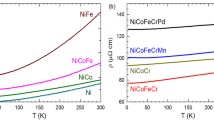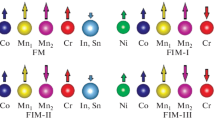Abstract
According to phase diagrams based on x-ray measurements, In70-Pt30 has the cubic Sn7Ir3 crystal structure (D8f, cI40) but the alloys In70-Ni30 and In70-Pd30 have been variously reported to have either a cubic gamma-brass (D81 − 3, cI52) or the Sn7Ir3 structures. In this study, hyperfine interaction measurements are applied as an alternate method to identify phases. Perturbed angular correlation (PAC) measurements were made of characteristic nuclear quadrupole interactions of 111In/Cd probe atoms, and demonstrated a common, characteristic “signature” of the Sn7Ir3 structure in all three alloys. The Sn7Ir3 structure has two inequivalent Sn-sites with a 3:4 ratio of atoms and point symmetries indicate that the electric-field gradients at both sites should be axially symmetric. Measured perturbation functions for all three alloys exhibited two axially symmetric quadrupole interaction signals having the expected 3:4 ratio of amplitudes, as expected for the structure. Furthermore, ratios of the two quadrupole interaction frequencies in each alloy were characteristically large, with frequencies for probe atoms on In(3) sites roughly five times greater than on In(4) sites. Taken together, these observations confirm that all three phases have the Sn7Ir3 structure. Quadrupole interaction frequencies are also reported for isostructural alloys of gallium with Pt, Pd and Ni. Negligible inhomogeneous broadening was observed in measurements near room temperature in all six phases, indicating excellent atomic ordering at the stoichiometric 70:30 compositions.
Similar content being viewed by others
References
White, C.E.T., Okamoto, H.: Phase Diagrams of Indium Alloys. ASM, Materials Park, OH (1992); Massalski, T.B., et al. (eds.): Binary Alloy Phase Diagrams, 2nd edn. ASM, Materials Park, OH (1990)
Baranova, R.V., Pinsker, Z.G.: Electron-diffraction study of the structure of the γ phase in the Ni-In system. Sov. Phys. Crystallogr. 10, 523–528 (1966)
Flandorfer, H.: Phase relationships in the In-rich part of the In-Pd system. J. Alloys Comps. 336, 176–180 (2002)
Okamoto, H.: In-Ni (Indium-Nickel). J. Phase Equilibria 24, 379 (2003)
Okamoto, H.: In-Pd (Indium-Palladium). J. Phase Equilibria 24, 481 (2003)
Swenson, D.: The Ir3Ge7 (D8 f ) structure: an electron phase related to g-brass. Mater. Res. Soc. Symp. Proc. 412, 367–72 (1997)
Schatz, G., Weidinger, A.: Nuclear Condensed Matter Physics. Wiley, New York (1996)
Pearson, W.B.: A Handbook of Lattice Spacings and Structures of Metals and Alloys. Pergamon, New York (1958)
Nieuwenhuis, E.R., Zacate M.O., Collins, G.S.: Simultaneous measurement of tracer jump frequencies on different sublattices in Ga7Pd3 using PAC. Diffus. Defect Data 264, 27–32 (2007)
Selim, F., Bevington, J.P., Collins, G.S.: Diffusion of 111Cd probes in Ga7Pt3 studied via nuclear quadrupole relaxation. Hyperfine Interact. 178, 87–90 (2007)
Author information
Authors and Affiliations
Corresponding author
Rights and permissions
About this article
Cite this article
Aspitarte, L., Nieuwenhuis, E.R. & Collins, G.S. Determination of the crystal structures of In70-Ni30 and In70-Pd30 using perturbed angular correlation. Hyperfine Interact 221, 73–78 (2013). https://doi.org/10.1007/s10751-012-0678-4
Published:
Issue Date:
DOI: https://doi.org/10.1007/s10751-012-0678-4




